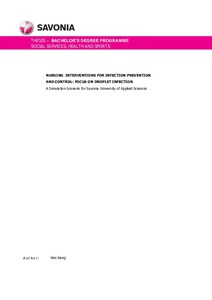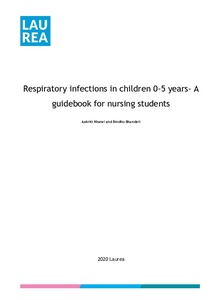Hospital Acquired Infection
Gbimue, Kingdom (2024)
Gbimue, Kingdom
2024
All rights reserved. This publication is copyrighted. You may download, display and print it for Your own personal use. Commercial use is prohibited.
Julkaisun pysyvä osoite on
https://urn.fi/URN:NBN:fi:amk-2024122538121
https://urn.fi/URN:NBN:fi:amk-2024122538121
Tiivistelmä
Hospital acquired infections are serious burden on hospitals, leading to poor patient outcome, increased costs and capable of terminating life. This thesis examines the causes and factors causing it and how to prevent hospital acquired infection using Jean Watson’s Theory of Human Caring, which focuses on holistic care, empathy, and personalized attention. It explores the roles of nurses, the importance of aseptic techniques, antibiotic consumption regulation, double checking of medication, Assessment of patient’s needs, patient education, and environmental controls in reducing and preventing hospital acquired infections. The study highlights the growing need for effective infection prevention strategies that combine technical expertise with compassionate care.
A scoping review methodology was used with a broad literature search of scientific database which included: EBSCO, CINAHL complete, PubMed, MEDLINE and Googlescholar. The research analysed how infection prevention measures align with Watson’s theory. Key findings show that aseptic practices like hand hygiene and sterile procedures are essential for protecting both patients and nurses. Environmental improvement and strong management culture also play crucial roles in creating safe caring spaces. Nurses’ contributions, particularly in education and monitoring, were found to be central to lowering hospital acquired infection and addressing antimicrobial resistance.
The study concludes that integrating Watson’s theory into infection control improves both patient safety and emotional wellbeing. It also suggests the use of advanced technologies, such as artificial intelligence, to monitor, detect, arrest, and neutralize airborne infections as well as to monitor and promote compliance with infection prevention practices. Hence, e-nurse which is driven by AI is therefore recommended for future studies and development.
A scoping review methodology was used with a broad literature search of scientific database which included: EBSCO, CINAHL complete, PubMed, MEDLINE and Googlescholar. The research analysed how infection prevention measures align with Watson’s theory. Key findings show that aseptic practices like hand hygiene and sterile procedures are essential for protecting both patients and nurses. Environmental improvement and strong management culture also play crucial roles in creating safe caring spaces. Nurses’ contributions, particularly in education and monitoring, were found to be central to lowering hospital acquired infection and addressing antimicrobial resistance.
The study concludes that integrating Watson’s theory into infection control improves both patient safety and emotional wellbeing. It also suggests the use of advanced technologies, such as artificial intelligence, to monitor, detect, arrest, and neutralize airborne infections as well as to monitor and promote compliance with infection prevention practices. Hence, e-nurse which is driven by AI is therefore recommended for future studies and development.
Kokoelmat
Samankaltainen aineisto
Näytetään aineisto, joilla on samankaltaisia nimekkeitä, tekijöitä tai asiasanoja.
-
NURSING INTERVENTIONS FOR INFECTION PREVENTION AND CONTROL: FOCUS ON DROPLET INFECTION A Simulation Scenario for Savonia University of Applied Sciences
Jiang, Wei (2021)The awareness of infection prevention and control has risen in the recent one year due to the COVID-19 pandemic spreading around the whole world. The pandemic was firstly outbreaking at the beginning of 2020, until today ... -
Hemodialysis Access Sites (HAS) and infection prevention
Adhikari, Krishna; Aryan, Attaulhaq (2019)Hemodialysis access sites are essential for the end stage renal disease patients for their treatment either long-term or short-term basis. These patients are in tremendous risk of infections due to invasive procedures on ... -
Respiratory infections in children 0-5 years - A guidebook for nursing students
Kharel, Aakriti; Bhandari, Bindhu (2020)The most common respiratory infections included in this thesis were the common cold, influenza, pharyngitis, laryngitis, epiglottitis, pneumonia, bronchiolitis, obstructive bronchitis, and ear infection (otitis media). ...



